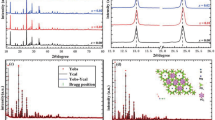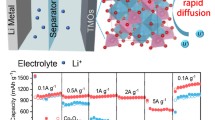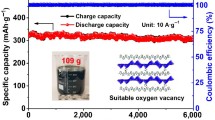Abstract
The development of cationic vacancies has been extensively examined as an effective strategy to improve the activity of electrocatalysts. However, it is a challenge to effectively introduce cationic vacancies on the material surface. Their specific effects on the electrochemical performance of lithium-oxygen (Li-O2) batteries are rarely reported. In this work, vanadium pentoxide with abundant vanadium vacancies (V2−xO5) is in situ prepared on the V2C MXene (V2−xO5@V2C MXene) surface, and their bifunctional catalytic activity toward the oxygen electrode reaction in Li-O2 batteries is systematically examined. The results show that the V2−xO5@V2C MXene-based Li-O2 battery exhibits excellent performance. It delivers a high energy efficiency of 83.4% at 100 mA g−1 and excellent cycling performance of more than 500 cycles. Furthermore, density functional theory calculations confirm that the presence of cationic vanadium vacancies can provide abundant active sites to reduce the reaction barrier and optimize the adsorption of reactants, increasing the oxygen electrode reactions in the Li-O2 battery. This work provides a meaningful view that modulating the electronic structure by creating cationic metal vacancies can improve the electrocatalytic activity of transition metal oxides.
摘要
构造阳离子空位被认为是一种可以提高电催化剂活性的有效策略. 然而, 在材料表面高效地引入阳离子空位仍面临诸多挑战. 另外, 关于阳离子空位对锂-氧气(Li-O2)电池氧电极反应活性的影响少有报道. 本文报道了在V2C MXene表面原位构造富含钒空位的五氧化二钒(V2−xO5@V2C MXene)的方法, 并系统研究了该材料对Li-O2电池氧电极反应的双功能催化活性. 结果表明, 基于V2−xO5@V2C MXene的Li-O2电池具有良好的性能. 其在100 mA g−1电流密度下展示出高的能量效率(83.4%)和优异的循环性能(超过500次循环). 密度泛函理论计算结果表明, 阳离子钒空位的存在可以提供大量活性位点以降低Li-O2电池氧电 极反应能垒并促进反应物的吸附. 本工作表明, 通过构造阳离子金属空 位来调节材料表面电子结构是提高过渡金属氧化物电催化活性的有效路径.
Similar content being viewed by others
References
Bian X, Zhang S, Zhao Y, et al. Layered double hydroxide-based photocatalytic materials toward renewable solar fuels production. InfoMat, 2021, 3: 719–738
Li Q, Zhang Y, Shi L, et al. Dynamic structure change of Cu nanoparticles on carbon supports for CO2 electro-reduction toward multi-carbon products. InfoMat, 2021, 3: 1285–1294
Wang P, Ren Y, Wang R, et al. Atomically dispersed cobalt catalyst anchored on nitrogen-doped carbon nanosheets for lithium-oxygen batteries. Nat Commun, 2020, 11: 1576
Niu P, Dai J, Zhi X, et al. Photocatalytic overall water splitting by graphitic carbon nitride. InfoMat, 2021, 3: 931–961
Wang P, Li C, Dong S, et al. Hierarchical NiCo2S4@NiO core-shell heterostructures as catalytic cathode for long-life Li-O2 batteries. Adv Energy Mater, 2019, 9: 1900788
Yan Y, Shu C, Zheng R, et al. Long-cycling lithium-oxygen batteries enabled by tailoring Li nucleation and deposition via lithiophilic oxygen vacancy in Vo-TiO2/Ti3C2T composite anodes. J Energy Chem, 2022, 65: 654–665
Li K, Zhang R, Gao R, et al. Metal-defected spinel MnxCo3−xO4 with octahedral Mn-enriched surface for highly efficient oxygen reduction reaction. Appl Catal B-Environ, 2019, 244: 536–545
Wu T, Sun M, Huang B. Strain modulation of phase transformation of noble metal nanomaterials. InfoMat, 2020, 2: 715–734
Zhang JY, Yan Y, Mei B, et al. Local spin-state tuning of cobalt-iron selenide nanoframes for the boosted oxygen evolution. Energy Environ Sci, 2021, 14: 365–373
Li J, Han K, Huang J, et al. Polarized nucleation and efficient decomposition of Li2O2 for Ti2C MXene cathode catalyst under a mixed surface condition in lithium-oxygen batteries. Energy Storage Mater, 2021, 35: 669–678
Zhu K, Wu T, Sun S, et al. Synergistic H+/Zn2+ dual ion insertion mechanism in high-capacity and ultra-stable hydrated VO2 cathode for aqueous Zn-ion batteries. Energy Storage Mater, 2020, 29: 60–70
Wan F, Niu Z. Design strategies for vanadium-based aqueous zinc-ion batteries. Angew Chem Int Ed, 2019, 58: 16358–16367
Du CF, Sun X, Yu H, et al. V4C3Tx MXene: A promising active substrate for reactive surface modification and the enhanced electrocatalytic oxygen evolution activity. InfoMat, 2020, 2: 950–959
Lukatskaya MR, Kota S, Lin Z, et al. Ultra-high-rate pseudocapacitive energy storage in two-dimensional transition metal carbides. Nat Energy, 2017, 2: 17105
Yu M, Wang Z, Liu J, et al. A hierarchically porous and hydrophilic 3D nickel-iron/MXene electrode for accelerating oxygen and hydrogen evolution at high current densities. Nano Energy, 2019, 63: 103880
Fang Y, Liu Z, Han J, et al. High-performance electrocatalytic conversion of N2 to NH3 using oxygen-vacancy-rich TiO2in situ grown on Ti3C2Tx MXene. Adv Energy Mater, 2019, 9: 1803406
Liu Y, Jiang Y, Hu Z, et al. In-situ electrochemically activated surface vanadium valence in V2C MXene to achieve high capacity and superior rate performance for Zn-ion batteries. Adv Funct Mater, 2020, 31: 2008033
Zuo Y, Rao D, Li S, et al. Atomic vacancies control of Pd-based catalysts for enhanced electrochemical performance. Adv Mater, 2018, 30: 1704171
Chen X, Yu M, Yan Z, et al. Boosting electrocatalytic oxygen evolution by cation defect modulation via electrochemical etching. CCS Chem, 2021, 3: 675–685
Zhong W, Wang Z, Gao N, et al. Coupled vacancy pairs in Ni-doped CoSe for improved electrocatalytic hydrogen production through topochemical deintercalation. Angew Chem Int Ed, 2020, 59: 22743–22748
Zheng R, Shu C, Chen X, et al. Unique intermediate adsorption enabled by anion vacancies in metal sulfide embedded MXene nanosheets overcoming kinetic barriers of oxygen electrode reactions in lithium-oxygen batteries. Energy Storage Mater, 2021, 40: 41–50
Cai Z, Bi Y, Hu E, et al. Single-crystalline ultrathin Co3O4 nanosheets with massive vacancy defects for enhanced electrocatalysis. Adv Energy Mater, 2018, 8: 1701694
Zhang R, Zhang YC, Pan L, et al. Engineering cobalt defects in cobalt oxide for highly efficient electrocatalytic oxygen evolution. ACS Catal, 2018, 8: 3803–3811
Wang Y, Qiao M, Li Y, et al. Tuning surface electronic configuration of NiFe LDHs nanosheets by introducing cation vacancies (Fe or Ni) as highly efficient electrocatalysts for oxygen evolution reaction. Small, 2018, 14: 1800136
Chen D, Qiao M, Lu YR, et al. Preferential cation vacancies in perovskite hydroxide for the oxygen evolution reaction. Angew Chem Int Ed, 2018, 57: 8691–8696
Kresse G, Furthmüller J. Efficiency of ab-initio total energy calculations for metals and semiconductors using a plane-wave basis set. Comput Mater Sci, 1996, 6: 15–50
Kresse G, Joubert D. From ultrasoft pseudopotentials to the projector augmented-wave method. Phys Rev B, 1999, 59: 1758–1775
Wu M, Wang B, Hu Q, et al. The synthesis process and thermal stability of V2C MXene. Materials, 2018, 11: 2112
Zhang W, Peng J, Hua W, et al. Architecting amorphous vanadium oxide/MXene nanohybrid via tunable anodic oxidation for high-performance sodium-ion batteries. Adv Energy Mater, 2021, 11: 2100757
Baddour-Hadjean R, Smirnov MB, Smirnov KS, et al. Lattice dynamics of β-V2O5: Raman spectroscopic insight into the atomistic structure of a high-pressure vanadium pentoxide polymorph. Inorg Chem, 2012, 51: 3194–3201
Guan Y, Jiang S, Cong Y, et al. A hydrofluoric acid-free synthesis of 2D vanadium carbide (V2C) MXene for supercapacitor electrodes. 2D Mater, 2020, 7: 025010
Liu F, Liu Y, Zhao X, et al. Prelithiated V2C MXene: A high-performance electrode for hybrid magnesium/lithium-ion batteries by ion cointercalation. Small, 2020, 16: 1906076
Ragupathi V, Krishnaswamy S, Raman S, et al. Enhanced electrochemical performance of LiCoBO3 cathode material for next generation lithium-ion batteries. Appl Surf Sci, 2018, 449: 421–425
Tang X, Zhou D, Li P, et al. MXene-based dendrite-free potassium metal batteries. Adv Mater, 2020, 32: 1906739
Song C, Zhang D, Wang B, et al. Uniformly grown PtCo-modified Co3O4 nanosheets as a highly efficient catalyst for sodium borohydride electrooxidation. Nano Res, 2016, 9: 3322–3333
Wang F, Liu W, Wang H, et al. Reduced Co3O4 nanowires with abundant oxygen vacancies as an efficient free-standing cathode for Li-O2 batteries. Catal Sci Technol, 2018, 8: 6478–6485
Kwak IH, Kwon IS, Debela TT, et al. Phase evolution of Re1−xMoxSe2 alloy nanosheets and their enhanced catalytic activity toward hydrogen evolution reaction. ACS Nano, 2020, 14: 11995–12005
Fan X, Liu Y, Chen S, et al. Defect-enriched iron fluoride-oxide nanoporous thin films bifunctional catalyst for water splitting. Nat Commun, 2018, 9: 1809
Sun Z, Lin L, Wei Y, et al. An in situ constructed topological rich vacancy-defect nitrogen-doped nanocarbon as a highly-effective metal-free oxygen catalyst for Li-O2 batteries. J Mater Chem A, 2019, 7: 21918–21926
Li J, Shu C, Hu A, et al. Tuning oxygen non-stoichiometric surface via defect engineering to promote the catalysis activity of Co3O4 in Li-O2 batteries. Chem Eng J, 2020, 381: 122678
Zhai Y, Wang J, Gao Q, et al. Highly efficient cobalt nanoparticles anchored porous N-doped carbon nanosheets electrocatalysts for Li-O2 batteries. J Catal, 2019, 377: 534–542
Zhao C, Zhu Y, Sun Q, et al. Transition of the reaction from three-phase to two-phase by using a hybrid conductor for high-energy-density high-rate solid-state Li-O2 batteries. Angew Chem Int Ed, 2021, 60: 5821–5826
Li G, Li N, Peng S, et al. Highly efficient Nb2C MXene cathode catalyst with uniform O-terminated surface for lithium-oxygen batteries. Adv Energy Mater, 2021, 11: 2002721
Zhao D, Wang P, Di H, et al. Single Semi-metallic selenium atoms on Ti3C2 MXene nanosheets as excellent cathode for lithium-oxygen batteries. Adv Funct Mater, 2021, 31: 2010544
Zhang H, Yang L, Zhang P, et al. MXene-derived TinO2n−1 quantum dots distributed on porous carbon nanosheets for stable and long-life Li−S batteries: Enhanced polysulfide mediation via defect engineering. Adv Mater, 2021, 33: 2008447
Zheng R, Shu C, Hou Z, et al. In situ fabricating oxygen vacancy-rich TiO2 nanoparticles via utilizing thermodynamically metastable Ti atoms on Ti3C2Tx MXene nanosheet surface to boost electrocatalytic activity for high-performance Li-O2 batteries. ACS Appl Mater Interfaces, 2019, 11: 46696–46704
Acknowledgements
This work was supported by the National Natural Science Foundation of China (21905033), the Science and Technology Department of Sichuan Province (2019YJ0503), and the State Key Laboratory of Vanadium and Titanium Resources Comprehensive Utilization (2020P4FZG02A).
Author information
Authors and Affiliations
Contributions
Author contributions Shu C conceived the project and directed the experiments. Xu H and Zheng R designed the experiments. Xu H and Zheng R carried out the material synthesis, device fabrication, and most of the measurements. Xu H wrote the manuscript. Shu C revised the manuscript. All authors contributed to the data analysis, discussed the results, and commented on the manuscript.
Corresponding author
Ethics declarations
Conflict of interest The authors declare that they have no conflict of interest.
Additional information
Haoyang Xu received his BSc degree from Chengdu University of Technology. He is now pursuing his Master degree under the supervision of Prof. Chaozhu Shu. His research interests mainly focus on the synthesis and characterization of nanomaterials for metal-air battery.
Ruixin Zheng received his Master degree (2021) from Chengdu University of Technology. His current research interests focus on the development of functional nanomaterials for emerging energy storage and conversion devices.
Chaozhu Shu received his BSc degree (2006) from Dalian University of Technology and PhD degree (2013) from Dalian Institute of Chemical Physics, Chinese Academy of Sciences. He is now a professor at the College of Materials and Chemistry & Chemical Engineering, Chengdu University of Technology. His research group works on materials for rechargeable batteries and electrocatalysis.
Supplementary information Supporting data are available in the online version of the paper.
Rights and permissions
About this article
Cite this article
Xu, H., Zheng, R., Du, D. et al. Cationic vanadium vacancy-enriched V2−xO5 on V2C MXene as superior bifunctional electrocatalysts for Li-O2 batteries. Sci. China Mater. 65, 1761–1770 (2022). https://doi.org/10.1007/s40843-021-1959-1
Received:
Accepted:
Published:
Issue Date:
DOI: https://doi.org/10.1007/s40843-021-1959-1




